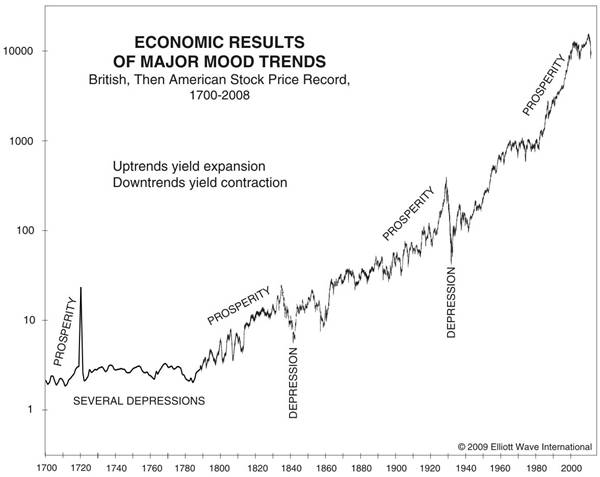
Pattern recognition is one of the earliest skills taught to children. From shapes and colors and animal recognition in early childhood we move on to learning sequences, and to make predictions based on patterns. The ability to spot existing or emerging patterns is probably the most critical skills in intelligent decision making. Pattern recognition helps us create order from chaos and has been an important survival skill throughout the ages.
Patterns help us predict what happens next with some degree of certainty, based on our common sense, intuition, and prior experience.
Charts are the ultimate pattern, and they tell the truth. Take a look at the chart below. It represents the entire 300 yr. history of stock markets prices.

Look closely at the declines. Every stock market decline large enough to stand out on this chart led directly to a great depression, and then a major war (Revolutionary, Civil, and WWII).
Now look at the time spans. The time span from the end of the previous depression to the beginning of the next one ranges between 60-70 years. It has been 80 years since the end of the last great depression.
If we are to protect ourselves and avoid the inevitable pitfalls of history, we have to anticipate developments. The only way we can do that is to use tools that reveal signs of approaching trend change.
Anticipating the turns
We have 300 years of market history and 90 years of market indicators on our side. The Elliott Wave tool that we rely on has signaled every major market turn since their discovery in 1931. The drive-while-looking-in-the-rear-view-mirror- tool that economists and the financial industry use have not signaled even one. They’re essentially a waste of time, and worse than that, they will lead you in the wrong direction at exactly the wrong time.
Over the past eight decades hundreds of theories and systems have been advanced claiming to be able to explain and predict stock market movements. Only one has proven to be of value – the Elliott Wave Principle.
Many of my readers are already familiar with the Elliott Wave Principle (EWP), and some, like me, have used it for many years in their trading. In the early 1930’s, after the great stock market crash of 1929, a genius named Ralph Nelson Elliott, began an extensive study of the history of stock market movements that resulted in one of the great discoveries in human history. To quote Elliott: “No truth meets more general acceptance than that the universe is ruled by law…The stock market illustrates the wave impulse common to social-economic activity…it has its law, just as is true of other things throughout the universe.”
Nothing is new
There’s a proverb that has come down through the ages, originally attributed to Solomon in Ecclesiastes 1:9 . He said, Whatever has happened, will happen again; whatever has been done, will be done again. There is nothing new under the sun. (ISV) Marcus Aurelius had a version, as did Shakespeare, and even Harry Truman gave it a spin with, There is nothing new in the world except the history you do not know.
As wise men have understood since the inception of the first pattern, history repeats itself. Fast forward a couple millennia, when RN Elliott discovered the laws that govern those patterns. What he called “Nature’s Law”, has allowed the foremost experts in the EWP, to predict every major stock market top and bottom (4) of the last eighty years. It’s worth noting again, of the hundreds of other theories and systems none has predicted even one.
The Wave Principle
Think back to the late 1970’s, when the mood was, as many of you may recall, one of deep pessimism. The number one nonfiction bestseller at the time was “How to Survive and Prosper from the Coming Depression”. I remember that my own mailbox was flooded with flyers of doomsday forecasts and economic disaster. Inflation was out of control, interest rates on government bonds were over 15%, and polls showed people were more fearful of the future than at any time since the 1940’s.
Enter the scene Robert Prechter and A.J. Frost. In 1978 they published their book “The Elliottwave Principle”. In it they forecast a great bull market, not doom and disaster. You can just imagine the reaction from the financial establishment.
Noted financial analyst, James W. Cowan, said many years later: “…that 1978 prediction must go down in history as the most remarkable stock market prediction of all time”
But Cowan was unfamiliar with another forecast. R.N. Elliott in October, 1942, against a similar backdrop of extreme pessimism by the financial industry and the public, wrote emphatically that the bottom was in, and that there would be a great bull market, and no depression for 70 years. Elliott understood, as has every expert Elliottician since, that when this advancing pattern completed there would be a Great Depression deeper than the 1930’s.
Prechter warned that almost everyone will be caught by surprise by its suddenness and intensity, leading to the eventual bottom a few years later, and what will be the greatest buying opportunity ever – but not until all assets have declined 75-90% first.
Prechter said: “The Wave Principle model falls well short of providing a crystal ball, but it is the very best financial market model available. It must suffice, because there is nothing better.”
Warning: The 300 yr. stock market chart clearly shows bull markets take the stairs up and bear markets the elevator down ↓
Prudence and good risk management requires, given the magnitude of what we face, that it is better to be early and not a day late in preparing for what, in high probability, lies directly ahead. This is especially true of illiquid assets like real estate, and debt.